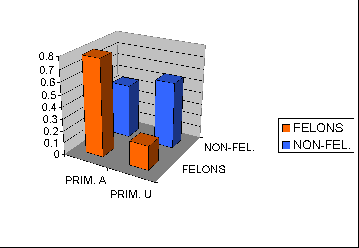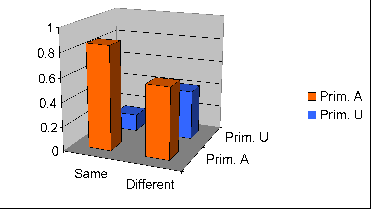|
|
| |
|
|
Life Circumstances and PAS Patterns
|
Felons,
Non-felons and the A - U Dimension of the PAS
Krauskopf and Saunders say:
"We
have hypothesized that people will seek out circumstances where
they can use their better skills and avoid their lesser ones.
One very general , but testable, prediction deriving from this
hypothesis is that different life circumstances should contain
people with different PAS patterns."(Personality and Ability:
The Personality Assessment System, 1994, p.46.)
The following
are some simple tests of that hypothesis. The first compares the
differences in the distribution of PAS patterns in a group of
634 incarcerated felons with that of 4931 non-institutionalized
U.S residents. These 4931 cases are drawn from a wide variety
of sources; there are probably some in this group that may have
been (or should have been) incarcerated. The test, therefore,
is a conservative one since the only characteristic that distinguishes
the non-felon group is that they were not institutionalized when
the data were obtained.
Here is a table showing the raw data:
Number
of cases: Felons and Non-Felons (Primitive PAS Types Shown)
|
ERA |
ERU |
EFA |
EFU |
IRA |
IRU |
IFA |
IFU |
Total |
| Felon |
155 |
34 |
49 |
20 |
216 |
48 |
88 |
24 |
634
|
| Non-Felon |
779 |
923 |
394 |
526 |
676 |
787 |
361 |
483 |
4931 |
These
data show a clear difference in the distributions of Primitive
PAS patterns between these two groups. (All results presented
below are significant at the .01 level or higher. Details may
be obtained by contacting PASF) The next chart shows these data
expressed as proportions:

These
results will surprise no one familiar with the PAS because of
the principle that we all tend to move toward those life-settings
that maximize our strengths and minimize our weaknesses. A primitive
A child has so little difficulty in adjusting to the varying demands
of those around him and pleasing them that four outcomes are more
likely for Primitive A's than for Primitive U's. These expected
outcomes are:
- Primitive
A children are more likely to evade the presures to compensate
than are primitive U's because of their ability to "appear"
to have learned social requirements when, in fact, they have
not.
- Primitive
A's would, therefore, be expected to reach adulthood with less
compensation than Primitive U's.
- The combination
of skill in social manipulativeness plus fewer of the self-controls
acquired through compensation should result in a larger proportion
of such people choosing to engage in anti-social behavior.
- We should,
therefore, expect to find more Primitive A's incarcerated than
Primitive U's.
In the table
and chart above, the PAS Primitive A - U dimension obviously carries
most of the weight in making the distinction between felons and
non-felons when compared with the other two PAS dimensions. If
we collapse the PAS space into the single dimension, A - U, we
see the importance of the A - U dimension as a discriminator between
these two groups.
Number
of cases: Felons and Non-Felons (Primitive PAS Types Shown)
|
Prim.
A |
Prim.
U |
Total |
| Felon |
508 |
126 |
634 |
| Non-Felon |
2212 |
2719 |
4931 |
This
chart shows these differences expressed as proportions.

This leads
us to an even more general expectation: There will be more Uncompensated,
Unmodified A's than Uncompensated, Unmodified U's, no matter where
we look. This expectation is borne out by examining the entire
PASF Master data base. The following chart compares the proportion
of Primitive A's who reach adulthood with neither Compensation
nor Modification with Primitve U's who do the same. That is, these
are the people who, as adults, have the same PAS pattern they
had as children. These data are drawn from the Personality Assessment
System Foundation Master Data Base of over 40,000 subjects. 19,056
of these were residents of the U.S, when the data were obtained;
this smaller sub-group provides the data for the following table
and chart.
Number
of cases:
|
Same
PAS |
Diff.
PAS |
Total |
| Prim
A |
155 |
11211 |
11366 |
| Prim
U |
26 |
7664 |
7690 |
The chart below shows these data expressed as proportions. Though
total lack of change is rare in any pattern, when it does happen,
the primitive pattern is more than four times as likely to contain
an A than a U.

The kinds
of distinctions shown above form the basis of David Saunders'
work with Reference Groups. Krauskopf and Saunders say that reference
groups are, "...a sophisticated method of looking at life
circumstance. The basis of this technique is the assumption that
if there is anything at all to the construct system and measurement
technique, [of the PAS] then persons with similar patterns of
scores should show highly similar behavior of some kind.... For
validation, the behavior identified should be consistent with
the theoretical predictions of the PAS pattern (or patterns) within
the group." (Krauskopf and Saunders, 1944, p.48.) For discussions
of Saunders' work on this topic, please visit Reference
Groups.
|
|
|
HOME | PAS | RESOURCES | TRAINING | CONFERENCES
ABOUT US | MEMBERS | JOIN | SITEMAP | CONTACT |
| |
| |
| |
|

